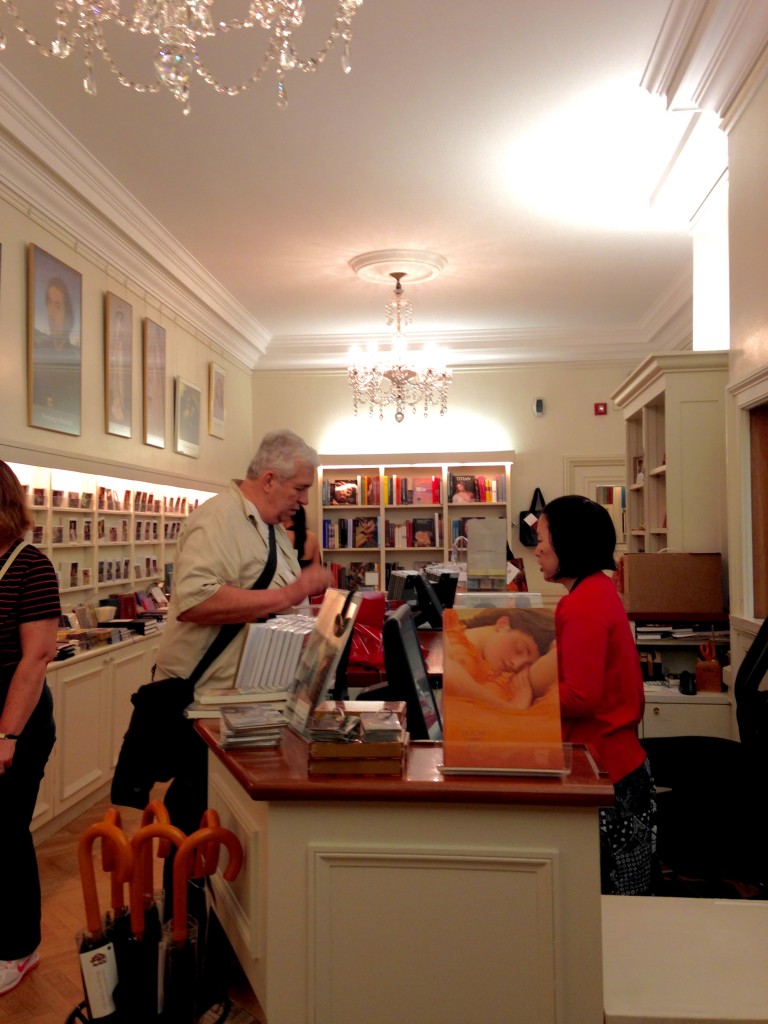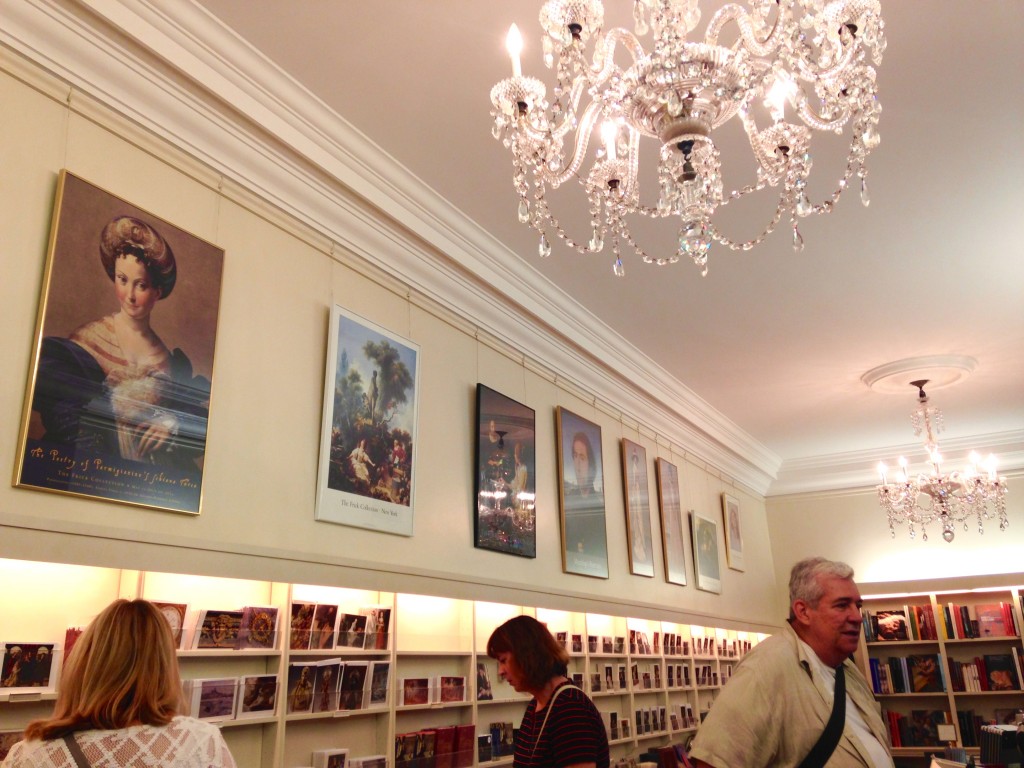The intimate display and context of the pieces presented in the Frick Museum maintain what Walter Benjamin described to be “aura” “the intentions, meanings, and skills integral to the production and appreciation of the objects” (Benjamin 1969) , thus keeping the central intent of the items in the gift shop located around the original aura of wealth and exclusivity of the piece.
Knowing the context of an artwork is a privileged and creates an intimate community, as reflected by the overwhelming support of members, and goes against the industrial concept of the modern museum by showcasing the art in situ. As Alison Clarke defines agency in art as interpretation, the Frick helps maintain agency by showcasing paintings in their intended social context and decorative usage.
In museological terms, the perception of objects has changed quite a bit of time since the days objects were displayed on pedestals as former didactic specimens or rare collectibles. The hierarchies that separated art and utility have given way, at least in some contemporary museum contexts, to more humanistic understandings of the value of things in which the material culture of urban life. is as valid for interpretation.
(Clarke 2014:17).
Within the higher realm of “culture” as our society likes to interpret the art world, there is a hierarchy of interpretation and display. In other words, there are varying levels of cultural capital among museums. Capitalist reproduction is mechanical by nature ‐ this type of uniform, blank reproduction is similar to that of the modern art gallery. The walls are typically blank and devoid of individual markers. You could not distinguish two galleries apart in the Metropolitan Museum of Art if the pieces were taken out. This type of display is associated with “pure art”, thus denying the social function of art.
The Frick Collection stands resolute on 70th Street and 5th Avenue, a mere ten blocks south of the Metropolitan Museum of Art and facing Central Park. Originally a private mansion for the Frick family, Henry Clay Frick had always intended for the house to be opened to the public following his death. In order to showcase his eye for art and aesthetic, he worked with interior designers to create a sensory experience throughout the ground floor of the museum. Over the years, the mansion has been fine tuned to accommodate a curious public but the original mission of the Frick estate has been preserved.
The Frick maintains the relationship between art and utility denying contemporary reproduction. Therefore, we can examine this industrial notion of reproduction outside of art, but in the spaces where art is housed. The Frick cultivates presence by decreasing the distance between visitor and context of art by maintaining it in a way it was meant to be viewed. It is a museum frozen in time, a permanent collection limited to the curatorial musings of Henry Clay Frick. In doing so, they reverse the industrial layout of a museum (which by nature takes it out of its intended purpose and place) : “the uniqueness of a work of art is inseparable from its being embedded in the fabric of tradition” (Benjamin, 1969). In the context of the Frick, this is evident in many ways, most interestingly in the retail space reserved in the Frick.
These ideologies are further enforced through the museum’s architecture the Frick family knew they wanted their mansion to be converted into a museum after their death, the big rooms and acute furnishings are intriguing to the eye of the visitor, but the mood remains residential. The rooms and art is so interesting due to the sheer volume of Gilded Age aesthetic, from ornate wall decorations to glittering sconces, to imposing paintings that stare down at the viewer. One feels as though they are trespassing in a private space, which leads to soft steps, whispers, and a heightened awareness of body space and movement.
The exclusivity is clearly evident in the tucked away feeling of the mansion, one cannot hear the sounds of 5th Avenue. An elevated garden hides any view of modern day Manhattan. There are no crowds as in the Metropolitan Museum of Art, and the notion of looking at private rooms is a thrilling experience.
From the exterior, the Frick’s museum store is indistinguishable from the other rooms in the mansion. Located by the only entry and exit out of the lobby, many visitors walking into the museum do not even notice its presence, as their eyes are drawn forward into the belly of the mansion to the gilded walls and enticing frames in which rest colorful paintings. It is the only part of the museum where there are clearly marked directions for visitors to walk as the rest of the museum is open to exploration granted that one does not step over the velvet barriers protecting fragile dining pieces. Similarly, the museum shop is the singular public space in the museum. Retail brings in an external force that is at first glance, unusual.

Throughout the museum, the art is viewed in context, retaining the agency of the pieces as Clarke would defend, and the gift shop’s layout is an attempt to reflect that. Prints are hung in frames on the wall. Built in bookshelves hold various books depicting the permanent collection, past visiting pieces (always on sale) and the Frick family. Larger books face outward, as one would expect to see on a coffee table. The faces of the postcards look out at eye level in well lit shelves. The stationary and journals are scattered around, some laying open as if ready to be used. The stationary and journals are indicators of leisure time. The simple painted walls are a surprise to the eyes after walking through the many gilded halls and rooms throughout the museum, but two chandeliers hanging from the ceiling are in line with the rest of the magnificent museum space.
The reproductions and printed items are all taken from resident pieces that reside in the
Frick’s permanent collection, thus accentuating the museum experience as Frick and not merely as an “art” experience, creating a singularly Frick viewing experience.
Visiting pieces such as Leighton’s Flaming June , have retail space set aside on the only table in the store. The only thing to wear in the store is a scarf, which is over $50. There are no t‐shirts sold, suggesting their audience is not the average tourist but a group of studious visitors: students and members. Membership status is truly evident in the retail space, the 10% discount members receive is marked on every product for sale. The most expensive items in the shop are Sèvres products, fine porcelain from France, similar to the ones that the Fricks would have used. They run around $300, in high contrast to the one dollar postcards that line the walls. However, even considering the high end Sèvres products that carry a name and weight similar to that of the Frick, if one has enough cultural capital to recognize the value, the median price of items in the gift shop is around $20. Upon examining their end of the year report and their 2013 990 Form, it appears that a significant amount, nearly three times that of the gift shop earnings, comes out of new membership. Ongoing membership is key to supporting the maintenance and low prices of the gift shop. This allows individuals with relatively low economic capital to enter the space (when tickets are easily discounted and gift store prices are low) but the cultural capital aspect is the greater barrier to entry.
This leads me to wonder what the demographics of membership include. Who is the
average member? What entices individuals to join and donate money to the institution? I think that it is more than the perks of being a member, which run relatively low in comparison to membership perks with the Metropolitan or MoMA, and instead is the direct accumulation of cultural capital by being associated with the Frick.
In conclusion, the movement away from contemporary and industrialized concepts of art display creates an exclusive and private space in which to view art in context, thus preserving the agency of the pieces. Along those lines, this creates a singular experience of attending not just an art museum, but the Frick Collection. Its privatized and exclusive nature is reinforced by the sheer splendor of wealth and intimate setting in a private home. The retail space is the intrusion of the public but aims to correct this foreign presence by cultivating its own aesthetic alongside the extravagant nature of the collection.

— Margaret Sanford
References Cited:
Benjamin, Walter. The Work of Art in the Age of Mechanical Reproduction. UCLA School of Theater, Film, and Television, 2005.
Clarke, Alison. “Theories of Material Agency and Practice: A Guide to Collecting Urban Material Culture.” Museum Anthropology 37.1 (2014): 17-26. Print.
Estrada, Andrea. “Origins of the Public Art Museum.” University of California. July 24, 2014. Accessed June 19, 2015.